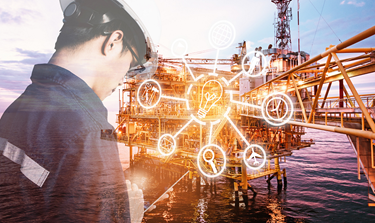The World Of Smart Asset Tracking: Q&A With Semtech
A conversation with Karthik Ranjan, LoRa Cloud™ solutions and partnerships leader in Semtech’s Wireless and Sensing Products Group.

Q: Can you summarize the current challenges of asset tracking today?
Ranjan: In short, continuous visibility and longevity of battery life are major challenges when it comes to asset tracking. Whether an organization tracks shipping containers across the Pacific Ocean, cattle across a large farm, or objects in motion on a construction-site, continuous visibility into your assets is crucial in gaining real-time insights into operational workflows. Proper sensing and connectivity platforms enable a consistent flow of data around key pieces of behavioral information. Continuous visibility into an organization’s assets is often challenging because in many cases assets travel across vast areas of the land, sky, and sea, shifting between indoor and outdoor locations. But, in hard-to-reach places like these, connectivity is frequently limited due to a restricted range of connectivity.
Only 10% of the world’s surface is covered by terrestrial networks, so to obtain global visibility into the supply chain—alternative complementary networks like satellite, have to come into play.
Q: Can asset tracking impact supply chain disruptions?
Ranjan: Supply chains continue to be volatile and unpredictable right now. Because of this, it’s crucial for companies to both sustain an agile mindset and deploy new solutions that promote agility within their workflows – like asset management. By receiving accurate data from end-to-end business practices, companies can have more control over their operations and can address disruptions proactively. While a single company cannot reduce shipping delays or port congestion, they can gain insights into the condition and state of their high-value assets, despite disruptions, backed by specific data like the location, temperature, and vibration data of their assets.
Overall, asset tracking can effectively help businesses operate more smoothly even in wake of industrywide disruptions. There are many ways to go about tracking assets, but ultimately the best strategies are individualized to meet specific organizational needs.
Q: How can IoT technology help?
Ranjan: Let’s take a step back to something I mentioned around the first question. A big obstacle in tracking assets is that often assets live or are transported in hard-to-reach areas. It’s more common than some might think. For instance, consider the vastness of remote, rural landscapes or the oceans and countries that assets have to travel through.
That said, much of asset tracking only requires small packets of data to be transmitted per interval. So, using high-bandwidth long-range connectivity platforms like 5G aren’t really necessary and more importantly can negatively impact battery life. Moreover, public cellular networks just aren’t available in very remote areas. However, what is necessary is having ultra-low power, long-range networks so these small packets of data can travel long distances from an IoT-enabled sensor to a tracking platform that can be set up anywhere. In areas of the world without cellular signals, satellite or low power wide area networks (LPWAN) can fill connectivity gaps that cellular cannot. IoT-enabled satellite connectivity in particular is typically easy to install within existing infrastructure and is an affordable, long-range solution compared to cellular.
When terrestrial networks are bridged with worldwide satellite connectivity, networks are far more accessible. In turn, tracking assets is then easier to achieve and more accurate in its reporting, which is critical when maintaining a stable supply chain.
When looking to track goods, shipments, or even animals that travel long distances – IoT-enabled connectivity and sensing platforms are a great low-power and efficient option.
Q: How will the Cloud optimize IoT technology further?
Ranjan: Although there are applications for on-premise, unconnected asset tracking such as in remote areas with limited connectivity, the limitations of having data locally without Cloud connectivity can limit the value which can be extracted from the data. By using IoT technology in tandem with Cloud solutions, asset tracking solutions can benefit from being able to roam between private and public LoRaWAN® networks such as combining private terrestrial with satellite networks enabling both cost and function optimization. This means the sensors can last much longer on a singular battery, broadening the applications that can benefit from precision geolocation.
With long-range, low-power sensors and location data enabled by the IoT, track and trace applications transmit data to the Cloud at a consistent interval – whether that interval spans from minute to minute or hour to hour. Device-to-Cloud geolocation services can help reduce hardware costs and optimize battery consumption by partitioning the workload between device and Cloud. Also, hyper-scale Cloud platforms enable companies to work with several assets. By connecting sensors to a Cloud application, companies can have access to the current and historical location of their assets on a digital tracking map.
Q: You recently made an announcement to help solve these challenges – can you explain?
Ranjan: Yes. We recently announced the release of a chip-to-Cloud service that uses our LoRa Cloud Locator. The new service allows customers to experience firsthand the capabilities of devices powered by LoRa Edge™, Semtech’s asset tracking solution for continuous indoor/outdoor location and enabling months to years of battery life. Once they’re set up on the platform, customers can view the tracker location of their assets in typically less than 15 minutes. This allows them to evaluate the capabilities of the platform for their specific need, which offers an ultra-low power and cost-effective solution for a variety of asset tracking applications.
The need for asset tracking is everywhere. The goal of this new service is to lower the barrier to entry to realize the benefits of IoT track-and-trace solutions.
Semtech, the Semtech logo, and LoRa are registered trademarks or service marks, and LoRa Cloud and LoRa Edge are trademarks or service marks, of Semtech Corporation or its affiliates
